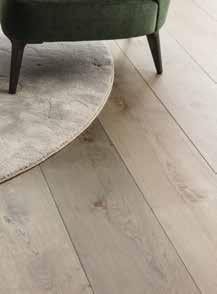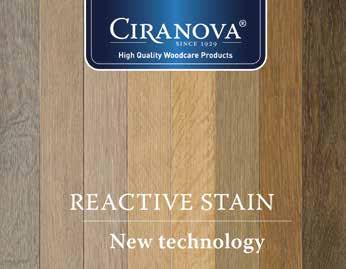
8 minute read
Special Who has products for giving a wooden floor/ parquet a distressed look?
OLD WOOD HAS RUN OUT! WHAT NOW?
THE RIGHT PRODUCTS CAN GIVE NEW WOOD AN OLD LOOK
Advertisement
Photo – Williams & Koch
Why should we distress wooden floors? The answer to that question is relatively simple: Real old floors or old wood from cloisters, castles, old train wagons, old and weathered bollards, cheese boards, and such like are now so scarce that prices also reflect that shortage. The ‘real stuff’ is for the happy few. Yet demand for those floors is no less great, so what do we do? To answer that question we need a solid dose of creativity and technique. ‘Chemistry’ invariably lends a hand as well.
Mechanical distressing In general, there are two ways to make new wooden floors look older, namely mechanical distressing and chemical distressing. Strictly speaking, we have two goals with mechanical distressing. Firstly, we want to give the impression that the floorboards have been produced using antiquated techniques from a century ago (brushing and scraping) and, secondly, give the impression that the floors have undergone years of use (by beating, drumming, and lashing).
Imitating old techniques We all know that technology is making great strides. Machines from about 10 years ago did not yield the same quality as those of today. That’s to say nothing about machines from 100 years ago! A century ago, it was not possible to saw straight without the sawing blade moving visibly. The same goes for planing! Likewise sanding. Whereas nowadays we can sandpaper to perfection by deploying various abrasives in succession, in ‘the good old days’ we had to rely on brushes. If we apply these old materials and techniques to a brand new oak wooden floor, we largely give the impression that the floor originates from ‘a different era’.
Imitating years of use Another way of distressing floors is to give the impression that they have been in use for decades. This can be done by creating marks of use. By beating and drumming, we give a floor certain damage which looks like traces of high traffic or consumption of floorboards by insects or micro-organisms. By making some small holes we can imitate woodworm damage, a frequent occurrence in older houses on floors in pine or pitch pine. Beating reinforces the used effect of the floor.
Chemical distressing Chemical products or interventions can affect the colour of the wood. With colour distressing we use special pigments or colour oils to give the impression that a new parquet floor is really an old one. Shades of white and grey are extremely popular for doing that. This is commonly called white wash or even super white wash. With the latter, the floor is brushed lightly first. If you apply a white wash, you get a floor which is matt and a little chalky. Extremely dark colours can also help to give an antique look. We also achieve dark colours by ‘smoking’.
Smoking Smoking wooden floors is one of the most popular and most attractive distressing techniques. Smoking is a process in which a reaction is generated with the tannic acid in the wood. A lot of wood sorts have either no or insufficient tannic acid to evoke an aged colour. Oak does have enough tannic acid, especially in the form of European oak and American oak. Russian or Chinese oak has much less tannic acid and can only be smoked lightly at best.
Reactive stains When we apply a reactive stain, the stain enters into a reaction with the tannic acid to bring about a discolouration in the stained wood. The discolouration is highly intense since it occurs in the cell wall of the wood. The final colour is affected by the amount of tannic acid in the wood. And so, that is the key to a unique floor covering. The tannic acid in wood is never identical in two different trees. Makers can present dozens of colours, but the end result will always depend on the tannic acid. An example of a reactive stain is the lye stain, which is widely sold. It gives a comparable effect to that obtained by the classic ‘leaching’. Oak wood, in particular, gives you the look of an aged floor.
What’s on the market ?
Blanchon
The range of distressing products such as powders, synthetic tints or positive tints, pigments in powder form, and several chemical agents for wood is endless. This is where professionals look for the fastest, simplest, and most economic solution. Blanchon offers parquet traders two ranges of wood tints in water phase. One (1K) is based on colouring agents, the other (2K) on pigments. There is also a range of reactive stains for distressing. All these products decorate, but they don’t protect. The durability in the lifespan of these products varies between ‘colouring agents’ and ‘pigments’. The latter are less sensitive to UV light.

Ciranova

Consumers and designers are looking away from uniformly stained, high-build, floor finishes and are looking for floors as though created by nature itself. Techniques, such as ammonia fuming, torching and chemical staining are well known and traditionally used to achieve these looks. In order to avoid those complex and hard to control manufacturing processes, Ciranova has invested heavily in

making techniques to obtain these finishes with only one treatment also suitable for the industrial user. The unique interface between carefully measured reducing chemicals that react with the components inside the wood, typically tannins and a sophisticated choice of fibre-coupling dyes combined with the unique Ciranova signature of a natural finish, form the basis of this New Technology. The most popular Ciranova product suitable for aging floors is our Reactive Stain New Technology. This stain is easy to apply and gives the wood an authentic look, an effect similar to the natural oxidation process. There are 4 inter-miscible Fumed colours from Light

Fumed to Deep Torched giving a sustainable alternative to fuming. This new product line in Reactive Stains is complimented by 4 interesting and desirable shades of Grey which are also intermiscible. Factoring in the natural variations of the wood and utilising correct finishing methods, this new technology enables the manufacturing of reproducible, stable, high quality and desirable wood floor finishes.
Chimiver OLD WEST
The R&D laboratory in CHIMIVER has developed a new and innovative range of reacting solutions for ageing your wood: OLD WEST. The use of OLD WEST allows to obtain a large variety of effects imitating the old weathered woods. OLD WEST is different from classical stains or dyes which are coloring the wood hiding its grain structure; OLD WEST enhances the natural beauty of wood standing out color differences into the wood grain. The OLD WEST reacting solutions are clear and pigments free; the natural wood color is changed through the reaction of the solution with the tannin or resins contained in the wood. Consider that the final results can change based on: - Quantity of product - Possible dilution of product - Reacting solution overlap - Humidity and temperature during working and drying. - Drying conditions in between the coats - Wood preparation (sanding, scraping, brushing etc..) - Application method - Tannin and resin content - Country of origin of the wood - Chemical nature (water or solvent-based) of the fixing prymer

DevoNatural®
Reactive 300-600-1200 is a reactive distressing product with a smoked effect for ‘oak’ parquet and wooden floors, doors, windows, furniture, etc. The product is an ecological mix of hexa hydrates and does not contain any harmful or irritating substances or ammonia! Reactive 300-600- 1200 can be applied only to oak! DevoNatural® Reactive is a distressing product which is available in three concentrations, namely 400, 600, and 1200. The higher the figure, the stronger the reactive distressing. On oak wood DevoNatural® Reactive gives the wood a naturally aged look. The effect can vary, depending on the area of growth, the sort of oak, and the diversity of the oak wood. The tannic acid content of the oak determines the colour effect!
Plastor
To give your parquet an aged and trendy look, Plastor offers HARD WAX OIL DECOPROTECT. This ready-for-use parquet oil preserves the natural look of parquet. Nine colours are available for giving parquet a more or less aged appearance. The number of coats applied can affect the final look of the parquet: the more coats, the more satiny the finish. This finish does not absorb the wood fibres and penetrates deeply without leaving a film on the surface. The oil makes parquet floors more resistant to stains and simplifies maintenance. Plastor is a dedicated brand and innovates to improve air quality to preserve traders’ health. That is why this product is graded as A +, which guarantees that only a small quantity of chemical particles are emitted into the air.

Williams & Koch

Williams & Koch is the top specialist in distressing products. New is the combination of PRM 60 with SMP 1230 and SMP 1260 which can instantly produce smoked and double-smoked effects without ammonia. Moreover, these products are not toxic, irritant, or harmful to the environment. The Linochrom grey-ageing products from the range have proved themselves for years through their unique operation and convenience. They are used both in the factory and on site. Branton B and Branton E are used to achieve extreme distressing effects. Here Williams & Koch offers fully fledged systems. Fumicolour (formerly Branton C3) consists of two base products with six special colouring agents and is the first distressing stain which can be fully coloured. Effects such as intense antique French cognac shades or oak liquorice, swamp oak, and tropical wood are within reach thanks to Fumicolour. In keeping with tradition, the Williams & Koch products contain only harmless chemicals.










